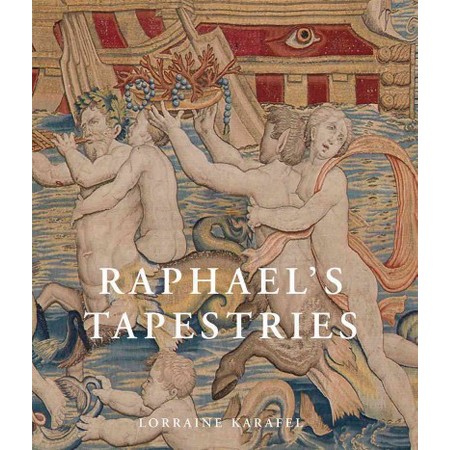HDCS Faculty Lorraine Karafel’s “Raphael’s Tapestries: The Grotesques of Leo X”
Posted on June 22, 2017 | posted by: adht
Assistant Professor of Art and Design History Lorraine Karafel’s most recent publication, Raphael’s Tapestries: The Grotesques of Leo X, was released earlier this year by Yale University Press. Raphael’s Tapestries was also selected by the American Library Association’s Choice Reviews as one of the Editors’ Picks for June 2017.
Around 1515, Raphael (1483-1520) designed a set of tapestries for Leo X, the first Medici pope. Each was sumptuously woven in gold, silver, and silk, and depicted scenes from classical mythology with inventive grotesques. Now lost, these spectacular, grand-scale textiles are reconstructed in Raphael’s Tapestries and set among a series of unprecedented decorative projects that Pope Leo commissioned from the artist. Likely produced by the Brussels weaver Pieter van Aelst, the tapestries pioneered a new all’antica style analogous with contemporary painted and sculpted interior programs. Tapestries played a central role at Leo’s court, as spectacle and as propaganda, and the Grotesques of Leo X would inform tapestry design for the next three centuries. Their beauty and complexity rivaled those of contemporary painting, and their luxurious materials made them highly prized. With this new study, the Grotesques take their rightful place as Renaissance masterworks and as documents of the fervent humanist culture of early 16th-century Rome.
Insights catches up with Dr. Karafel to learn a bit more about her research and its relevance today.
Why Grotesques? Can you share an interesting or notable motive behind Pope Leo’s/Raphael’s subject choice for this commission?
We are not really sure of the exact planning and design process for the Grotesques. However, evidence suggests that the subject would have been chosen by the patron, Pope Leo X. He probably consulted with the designer, Raphael, and would have worked closely with the program writer, in this case probably the papal cleric, Tommaso Inghirami.
Grotesques present inventive and decorative images of curious or mythological creatures, often metamorphosing from human to animal to plant. They were inspired by wall paintings discovered in the late 15th century at the ancient Roman villa, the Domus Aurea or Nero’s Golden House. The motifs became known as “grotesques” because they were found in the “grotti” – or caves – as the underground ruins were known. Artistically and politically, the designs connected the tapestries not only to this exciting new imagery but also to the culture and power of ancient Rome.
What relevance do these tapestries hold today?
Tapestries have gained new attention in recent years as fascinating art works, important historically as interior decoration but also as significant markers of prestige and wealth. Several exhibitions, including two here in New York at the Metropolitan Museum of Art, Tapestries in the Renaissance: Art and Magnificence (2002) and Tapestry in the Baroque: Threads of Splendor (2007), revealed these textiles as still commanding works of art. Ambitious, new research has shed considerable light on complex designs and production practices as well as the use of these monumental, multi-piece sets.
We have new appreciation for the importance of design work for towering figures in early modern art history, from Leonardo da Vinci, Sandro Botticelli, and Andrea Mantegna to Peter Paul Rubens and Charles Le Brun. In my research, I have found that Raphael’s work as a designer is at the very heart of his artistic production in Rome in the early 16th century as he invented designs for buildings, interiors, dishes, and, of course, tapestries.
For designers today, tapestry offers a window into new ways of thinking about textiles for the interior and even for temporary environments: their practical use as insulation pairs with their potential to bring color, texture, and narrative meaning for considerable visual impact.
What are some of your favorite pieces of knowledge gained in your research for this in-depth study? Is there anything in particular that you hope this study might elucidate for others?
The most important discovery I made during the project’s very long and intricate research process was a very simple one: how to see these tapestries. Complicated even confusing imagery makes the designs for the Grotesques of Leo X very difficult to read and understand. What should we make of scenes with the pagan god, Bacchus, or the hero, Hercules, presented in tapestries for the leader of the Christian church?
Also, existing examples of the Grotesques are later re-weavings, not from the original set made for Pope Leo X and the Vatican Palace, which is now lost. However, in the context of the papal court in the early 16th century, those decorative images, a fascinating collaboration between the program writer, designer, weaver, and patron, revealed themselves to have very specific roles in delivering the religious, cultural, political message of Pope Leo’s papacy and in celebrating Pope Leo himself. These multiple layers of meaning make the tapestries powerful cultural documents and are as intricately woven as the textiles themselves!
Raphael’s Tapestries: The Grotesques of Leo X can be found on the Yale University Press website.
Click here to read more of Dr. Karafel’s insights to her latest work on the Yale University Press official London blog.

